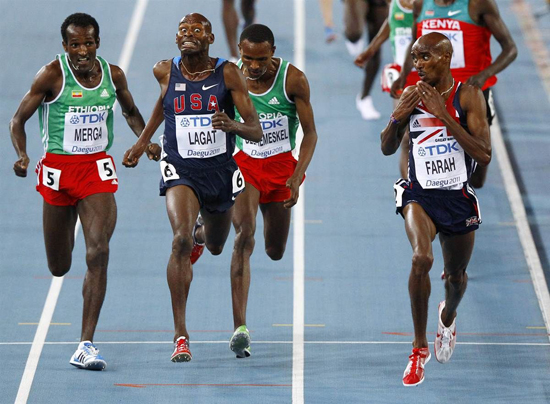The Health Risks of Running in the Heat and Humidity
Summertime Offers a Mixture of Joy and Pain to Runners; but Heat and Humidity can be Life-Threatening
Copyright © Kelly Smith All rights reserved; content may not be copied, rewritten, or republished without author’s written permission; Author’s Google profile; Posted May 30, 2011

 Your human body is very efficient at the job of maintaining an acceptable healthy temperature during a wide range of weather conditions. During cold conditions it achieves this by retaining generated heat. However, during hot summer conditions it must strive to do just the opposite. It must dissipate unwanted heat to try to lower your core temperature down to an acceptable normal 37°C (98.6°F) and your skin’s temperature to 33°C (91°F).
Your human body is very efficient at the job of maintaining an acceptable healthy temperature during a wide range of weather conditions. During cold conditions it achieves this by retaining generated heat. However, during hot summer conditions it must strive to do just the opposite. It must dissipate unwanted heat to try to lower your core temperature down to an acceptable normal 37°C (98.6°F) and your skin’s temperature to 33°C (91°F).
There are two normal ways your body attempts to shed unwanted heat are increasing blood flow to the skin (to radiate it away), and by sweating (the radiator effect). But here’ the fly in the ointment, when the humidity level is excessive, perspiration is not an efficient method at cooling by evaporation. You can’t saturate the saturated.
Serina McEntire, PhD, is an exercise physiologist who is well-versed in warm, humid weather running. She says, “Core temperature can reach dangerous levels within 10 minutes without adequate dissipation.” The end result of this situation can be several dangerous heat-related illnesses. The two most common? Heat cramps and heat stroke. Stroke can lead to death if it is not properly treated immediately.
The Symptoms and Recommended Treatment of Heat-Related Illnesses
The heat cramp affiction rears its ugly head as an uncomfortable pain, various muscle spasms, or both. Afflicted areas are commonly your diaphragm and/or your legs and is caused by dehydration as well as an electrolyte imbalance. Any runner that experiences these symptoms should cease running immediately, go to a cool area, sit down and rest, while drinking a cold electrolyte-fortified sports beverage like Gatorade® or Powerade®.
Exertional heat stroke, which is a form of hyperthermia, is a much more serious condition. It can occur when your core body temperature rises above 40.5° (104.9°F). One of the primary issues associated with heat stroke, unlike simple cramps, is that one of the effects can be a state of mental confusion or a feeling of disorientation. In this situation the runner might not realize his condition.Logically, he may not realize the need to stop and seek medical aid. This often occurs while racing or while training for a marathon, when a highly competitive nature can trump common sense.
One recommended treatment for the heat stroke condition is lowering the body’s temperature by immersion in an ice bath. If this is not practical, at the very least apply ice or ice packs under the arm pits and in the groin region. These two areas are where rapid cooling of the core temperature is more likely to be effective. If even this is not possible, remove excess clothing and spray the runner’s body using a garden hose.
Ways to Avoid Heat Stroke and Cramps
Many prevention measures are just common sense. First, hydration combined with a good electrolyte balance is key. This is not to say simply start drinking right before the training run or event; start it during the 24 hours before your run. Also, it makes sense that runners working out every day must make it a habit to keep a water bottle close at hand all day, summer and winter.
Are you a beginning runner? Ease into it. Do not simply leap into a full-blown training program during the middle of the hot season. The process we are talking about is called acclimation. Begin your program (working out early in the morning or late in the evening) with a comfortable number of minutes per day. Then build up your time and mileage gradually. The bottom line? Have fun, stay fit, but be aware of the dangers and use common sense.
Resources:
- www.RunningAcrossTexas.com; "Running in the Heat and Humidity"
- www.MedicineNet.com; "Heat Stroke", p.2
- www.mayoclinic.com/health/first-aid-heatstroke/FA00019
More Health and Wellness Articles
- Inexpensive Methods to Help You Stay Healthy and Fit
- The Facts on Performance Enhancing Supplements Marketed to Runners
- The Glycemic Index is the Key to Energy and Endurance
- 3 Herbal Teas for Immune System Support
